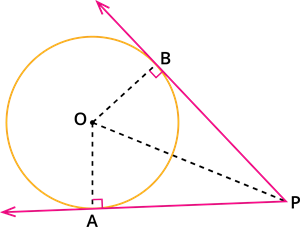PDF chapter test TRY NOW
Statement:
The lengths of tangents drawn from an exterior point to a circle are equal.
Proof for the theorem:
Consider a circle with centre O.
Let PA and PB be the two tangents drawn from the external point P to the circle.
Construction:
Join OA, OB and OP.

To prove:
The tangent PA = The tangent PB
Proof:
By the theorem 1, we have:
The tangent at any point of a circle is perpendicular to the radius through the point of contact.
OB \perp PB and OA \perp PA.
Here, OA and OB are radius. Hence, they are equal.
The side OP is a common side to the triangles AOP and BOP.
Therefore, by the RHS rule (In two right-angled triangles, if the length of the hypotenuse and one side of one triangle is equal to the length of the hypotenuse and corresponding side of the other triangle, then the two triangles are congruent.), the triangles AOP and BOP are congruent.
We know that the corresponding parts of the congruent triangles are equal.
Therefore, PA = PB.
Example:
In the above given figure if OB = 3 cm and OP = 5 cm, find the length of PA.
Solution:
By the theorem 1, we have:
A tangent at any point on a circle and the radius through the point are perpendicular to each other.
\angle OPB = 90^{\circ}.
So, OPB is a right angled triangle.
By the Pythagoras theorem, we have:
In a right triangle, the square of the hypotenuse is equal to the sum of the squares of the other two sides.
OP^2 = OB^2 + PB^2
PB^2 = OP^2 -OB^2
PB^2 = 5^2 - 3^2
PB^2 = 25 - 9
PB^2 = 16
\Rightarrow PB = \sqrt{16}
PB = 4
Thus, the measure of PB = 4 cm
By the theorem 2, we have:
The lengths of the two tangents drawn from an exterior point to a circle are equal.
Hence, PA = PB.
Therefore, the measure of PA = 4 cm
Important!
In the above given figure, \angle OPA = \angle OPB where OP is the angle bisector of \angle APB.
